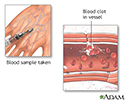Acquired platelet function defect
Acquired qualitative platelet disorders; Acquired disorders of platelet function
Acquired platelet function defects are conditions that prevent clotting elements in the blood called platelets from working as they should. The term acquired means these conditions are not present at birth.
Causes
Platelet disorders can affect the number of platelets, how well they function, or both. A platelet disorder affects normal blood clotting.
Disorders that can have problems with platelet function include:
- Idiopathic thrombocytopenic purpura (bleeding disorder in which the immune system destroys platelets)
- Chronic myelogenous leukemia (blood cancer that starts inside bone marrow)
- Multiple myeloma (blood cancer that starts in the plasma cells in the bone marrow)
- Primary myelofibrosis (bone marrow disorder in which the marrow is replaced by fibrous scar tissue)
- Polycythemia vera (bone marrow disease that leads to an abnormal increase in the number of blood cells)
- Primary thrombocythemia (bone marrow disorder in which the marrow produces too many platelets)
- Thrombotic thrombocytopenic purpura (blood disorder that causes blood clots to form in small blood vessels)
Other causes include:
- Kidney (renal) failure
- Medicines such as aspirin, ibuprofen, other anti-inflammatory drugs, penicillin, phenothiazines, and prednisone (after long-term use)
Symptoms
Symptoms may include any of the following:
- Heavy menstrual periods or prolonged bleeding (more than 5 days each period)
- Abnormal vaginal bleeding
- Blood in the urine
- Bleeding under the skin
- Bruising easily or pinpoint red spots on the skin
- Gastrointestinal bleeding resulting in bloody, dark black, or tarry bowel movements; or vomiting blood or material that looks like coffee grounds
- Nosebleeds
Exams and Tests
Tests that may be done include:
- Platelet function
- Platelet count
- Prothrombin time (PT) and partial thromboplastin time (PTT)
Treatment
Treatment is aimed at fixing the cause of the problem:
- Bone marrow disorders are often treated with platelet transfusions or removing platelets from the blood (platelet pheresis).
- Chemotherapy may be used to treat an underlying condition that is causing the problem.
- Platelet function defects caused by kidney failure are treated with dialysis or medicines.
- Platelet problems caused by a certain medicine are treated by stopping the drug.
Outlook (Prognosis)
Most of the time, treating the cause of the problem corrects the defect.
Possible Complications
Complications may include:
- Bleeding that does not stop easily
- Anemia (due to excessive bleeding)
When to Contact a Medical Professional
Contact your health care provider if:
- You have bleeding and do not know the cause
- Your symptoms get worse
- Your symptoms do not improve after you are treated for an acquired platelet function defect
Prevention
Using medicines as directed can reduce the risk for drug-related acquired platelet function defects. Treating other disorders may also reduce the risk. Some cases cannot be prevented.
References
Gross PL, Lopez JA. Acquired disorders of platelet function. In: Hoffman R, Benz EJ, Silberstein LE, et al, eds. Hematology: Basic Principles and Practice. 8th ed. Philadelphia, PA: Elsevier; 2023:chap 128.
Hall JE, Hall ME. Hemostasis and blood coagulation. In: Hall JE, Hall ME, eds. Guyton and Hall Textbook of Medical Physiology. 14th ed. Philadelphia, PA: Elsevier; 2021:chap 37.
Jobe SM, Di Paola J. Congenital and acquired disorders of platelet function and number. In: Kitchens CS, Kessler CM, Konkle BA, Streiff MB, Garcia DA, eds. Consultative Hemostasis and Thrombosis. 4th ed. Philadelphia, PA: Elsevier; 2019:chap 9.
Review Date: 2/2/2023
Reviewed By: Mark Levin, MD, Hematologist and Oncologist, Monsey, NY. Review provided by VeriMed Healthcare Network. Also reviewed by David C. Dugdale, MD, Medical Director, Brenda Conaway, Editorial Director, and the A.D.A.M. Editorial team.













